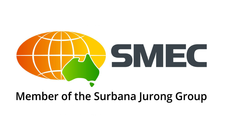New retaining-wall technology introduced into South Africa
The design of the MSE walls involved close collaboration between SMEC South Africa, Kaytech Engineered Fabrics and Tensar. Developed as an alternative to traditional retaining wall options, the Tensar TW1 system has been introduced to the local market by Kaytech. The system has been used extensively in Europe and elsewhere to date.
SMEC South Africa undertook the final design checks to ensure the overall stability of the system and its compliance with project specifications and local codes. “These included integration of the system with the new roadway and New Jersey barriers along the top of the wall. We also had to take cognisance of the overall geotechnical conditions,” explains Fernando Pequenino, Section Manager: Geotechnics, SMEC South Africa.
The geotechnical investigation revealed that the site was underlain by thick coastal dune Berea deposits at the precise location of the MSE walls, with bedrock at depths exceeding 30 m. The design of the MSE walls was based on SANS207: 2006: ‘The design and construction of reinforced soils and fills’, which provides applicable guidance for the design of reinforced walls.
“A reinforced soil structure must be checked for external and internal stability,” notes Pequenino. External stability takes into account sliding, bearing/tilt and overturning of the MSE block. Internal stability involves essential checks for failure against pull-out of the geogrid, as well as failure against rupture. Ancillary checks include compressive block failure, block rotation and bulging and connection failures.
“The type of geosynthetic reinforcement selected must also take into account the soil properties of the reinforced, retained and foundation materials,” adds Pequenino. These soil properties contribute to determining the tensile strength, stiffness requirements and spacing of the geogrid.
A key consideration of the design was to optimise the use of lower-quality fill material, while simultaneously reducing the quantity of lateral support required in cutting back and benching into the existing roadway (that is, the back excavation slope).
However, the use of such lower-quality fill material meant that the strip lengths had to be increased, which implied either an increased cut or the use of a near vertical back excavation slope requiring the use of shotcrete and ground anchors or nails.
“After a number of design iterations, the final design of the 11m-high wall comprised the use of 7m-long strips, a granular (COLTO G6) backfill for most of the height and a 1m-thick granular soil-raft foundation,” elaborates Frans van der Merwe, Engineer: Geotechnics, SMEC South Africa. Berea sand was used throughout for the upper 3m of the 11m wall and the 5m-high wall.
Ballito Drive is located about 40 km north-east of Durban. The scope of work on this project entailed widening the two-lane single carriageway to a three-lane dual carriageway. The undulating topography of the site meant that earth-retaining structures had to be built to bring the extra lanes to level.
The lane widening had to carried out within the road reserve to eliminate encroachment into existing developments. “In order to achieve this goal, two near-vertical MSE walls of 11m and 5m, covering a total length of over 400m and 2 000m2, were proposed,” adds van der Merwe.
MSE walls comprise fill material with horizontal layers of reinforcing elements. This may take the form of sheets, grids, strips or meshes. These metallic or polymeric reinforcing elements are capable of sustaining tensile loads and the effects of deformation or soil strains developed in the fill, part of which is transferred to the clad face through some form of positive connection.
Main contractor Afriscan Construction opted for the Tensar TW1 proprietary MSE system, introduced into the South African market by Kaytech. The system provides a number of benefits over other block and mechanically stabilised earth systems.
These include the effective connection between block and geogrid, a near-vertical face inclination, locally manufactured blocks, aesthetic appeal and labour-intensive construction, which eliminates the use of heavy lifting equipment.
Ends
Notes to the Editor
To download high resolution images for this press release, please visit http://media.ngage.co.za and click on the SMEC South Africa link to view the company’s press office.
About SMEC South Africa
SMEC South Africa provides consultancy services for the lifecycle of a project to a broad range of sectors. These include hydropower, transport, water, natural resources and environment, geotechnical, mining, tunnelling, urban development, renewable energy, power, government and advisory services and social infrastructure development. The SMEC Group has over 5 300 employees and an established network of over 75 offices throughout Australia, Africa, Asia, the Middle East, the Pacific, North and South America.
Media Contact
Gerhard Hope
NGAGE Public Relations
Phone: (011) 867-7763
Fax: 086 512 3352
Cell: 078 824 8723
Email: gerhard [at] ngage [dot] co [dot] za
Web: www.ngage.co.za
Browse the NGAGE Media Zone for more client press releases and photographs at http://media.ngage.co.za

